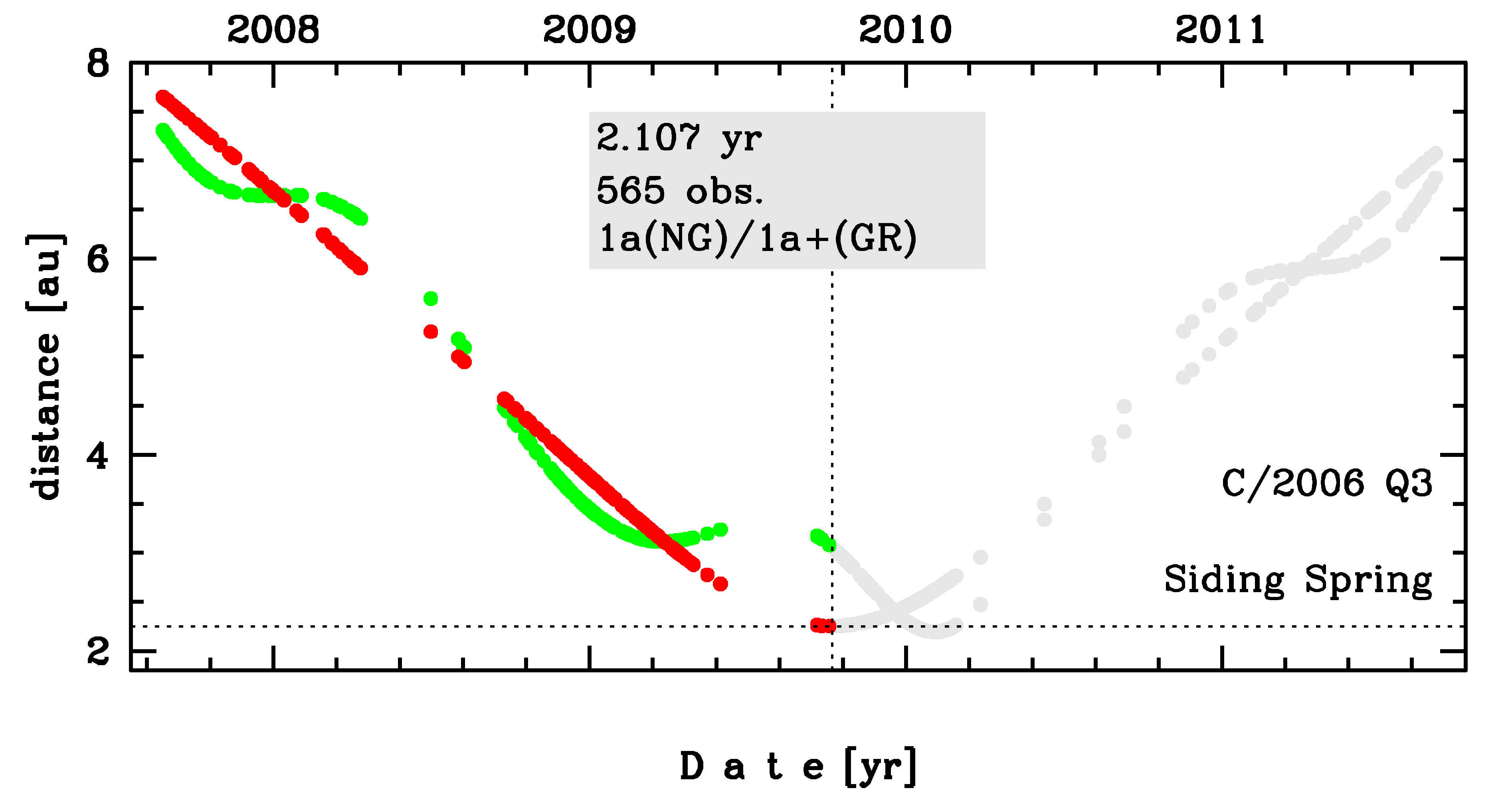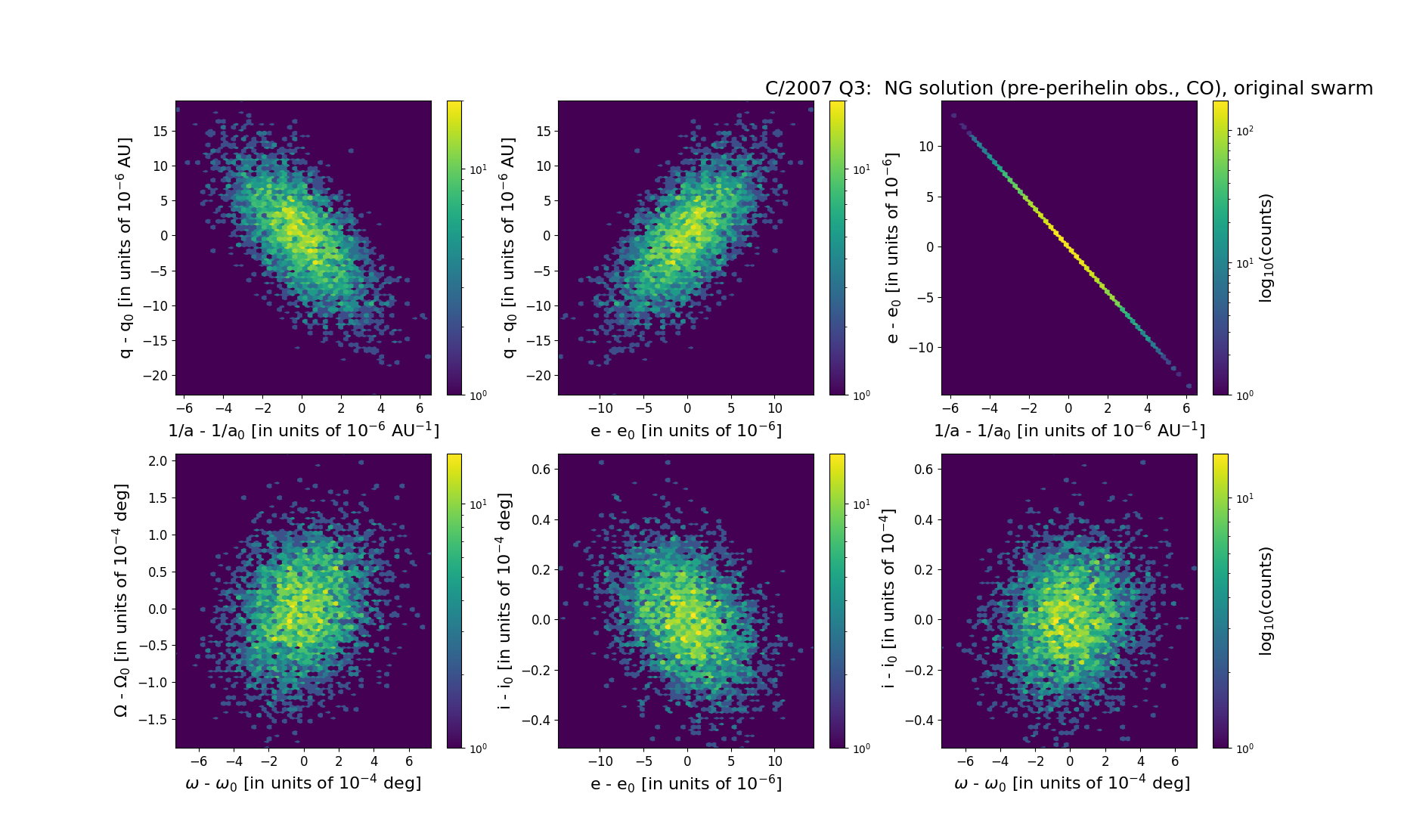C/2007 Q3 Siding Spring
more info
Comet C/2007 Q3 was discovered on 25 August 2007 with Siding Spring survey; that is a bit more than 2 years before its perihelion passage. It was observed until 3 September 2011 (see picture).
Comet had its closest approach to the Earth on 2 February 2010 (2.193 au), about 4 months after its perihelion passage.
C/2007 Q3 is a comet with non-gravitational effects strongly manifested in positional data fitting. Preferred (non-gravitational) solution given here is based on data spanning over 4.02 yr in a range of heliocentric distances: 7.64 au – 2.252 au (perihelion) – 7.07 au. However, it was difficult to indicate the preferred model for this comet. Therefore, we show also second global non-gravitational solution based on g(r)-like function dedicated to CO (dc solution based on data taken at large heliocentric distances). In addition, there are two further solutions: NG orbit for pre-perihelion arc of data (g(r)-like function consistent with CO) dedicated for past orbital evolution, and a pure gravitational orbit based on post-perihelion data taken at heliocentric distances starting from 3.5 au and dedicated to future evolution. From the dynamical perspective, all these solutions give a fairly precise range of original 1/a values from 28 to 41 in units of 10-6 au-1. The solution given in the Nakano Notes (NG orbit) is also placed inside this range of original 1/a, but the MPC solution (GR orbit) results in a slightly lower value of original 1/a.
This Oort spike comet suffers rather large planetary perturbations during its passage through the planetary system and these perturbations lead to more tight future orbit (see future barycentric orbits).
See also Królikowska and Dybczyński 2013 and Królikowska 2020.
Comet had its closest approach to the Earth on 2 February 2010 (2.193 au), about 4 months after its perihelion passage.
C/2007 Q3 is a comet with non-gravitational effects strongly manifested in positional data fitting. Preferred (non-gravitational) solution given here is based on data spanning over 4.02 yr in a range of heliocentric distances: 7.64 au – 2.252 au (perihelion) – 7.07 au. However, it was difficult to indicate the preferred model for this comet. Therefore, we show also second global non-gravitational solution based on g(r)-like function dedicated to CO (dc solution based on data taken at large heliocentric distances). In addition, there are two further solutions: NG orbit for pre-perihelion arc of data (g(r)-like function consistent with CO) dedicated for past orbital evolution, and a pure gravitational orbit based on post-perihelion data taken at heliocentric distances starting from 3.5 au and dedicated to future evolution. From the dynamical perspective, all these solutions give a fairly precise range of original 1/a values from 28 to 41 in units of 10-6 au-1. The solution given in the Nakano Notes (NG orbit) is also placed inside this range of original 1/a, but the MPC solution (GR orbit) results in a slightly lower value of original 1/a.
This Oort spike comet suffers rather large planetary perturbations during its passage through the planetary system and these perturbations lead to more tight future orbit (see future barycentric orbits).
See also Królikowska and Dybczyński 2013 and Królikowska 2020.
| solution description | ||
|---|---|---|
| number of observations | 565 | |
| data interval | 2007 08 25 – 2009 10 03 | |
| data arc selection | data generally limited to pre-perihelion (PRE) | |
| range of heliocentric distances | 7.64 au – 2.25au | |
| type of model of motion | NC - non-gravitational orbits for symmetric CO-g(r)-like function | |
| data weighting | YES | |
| number of residuals | 1112 | |
| RMS [arcseconds] | 0.29 | |
| orbit quality class | 1a | |
| orbital elements (barycentric ecliptic J2000) | ||
|---|---|---|
| Epoch | 1709 01 22 | |
| perihelion date | 2009 10 07.08505274 | ± 0.00106892 |
| perihelion distance [au] | 2.25547130 | ± 0.00000581 |
| eccentricity | 0.99993631 | ± 0.00000392 |
| argument of perihelion [°] | 2.066399 | ± 0.000195 |
| ascending node [°] | 149.432064 | ± 0.000056 |
| inclination [°] | 65.620404 | ± 0.000016 |
| reciprocal semi-major axis [10-6 au-1] | 28.24 | ± 1.74 |
| file containing 5001 VCs swarm |
|---|
| 2007q3pc.bmi |

